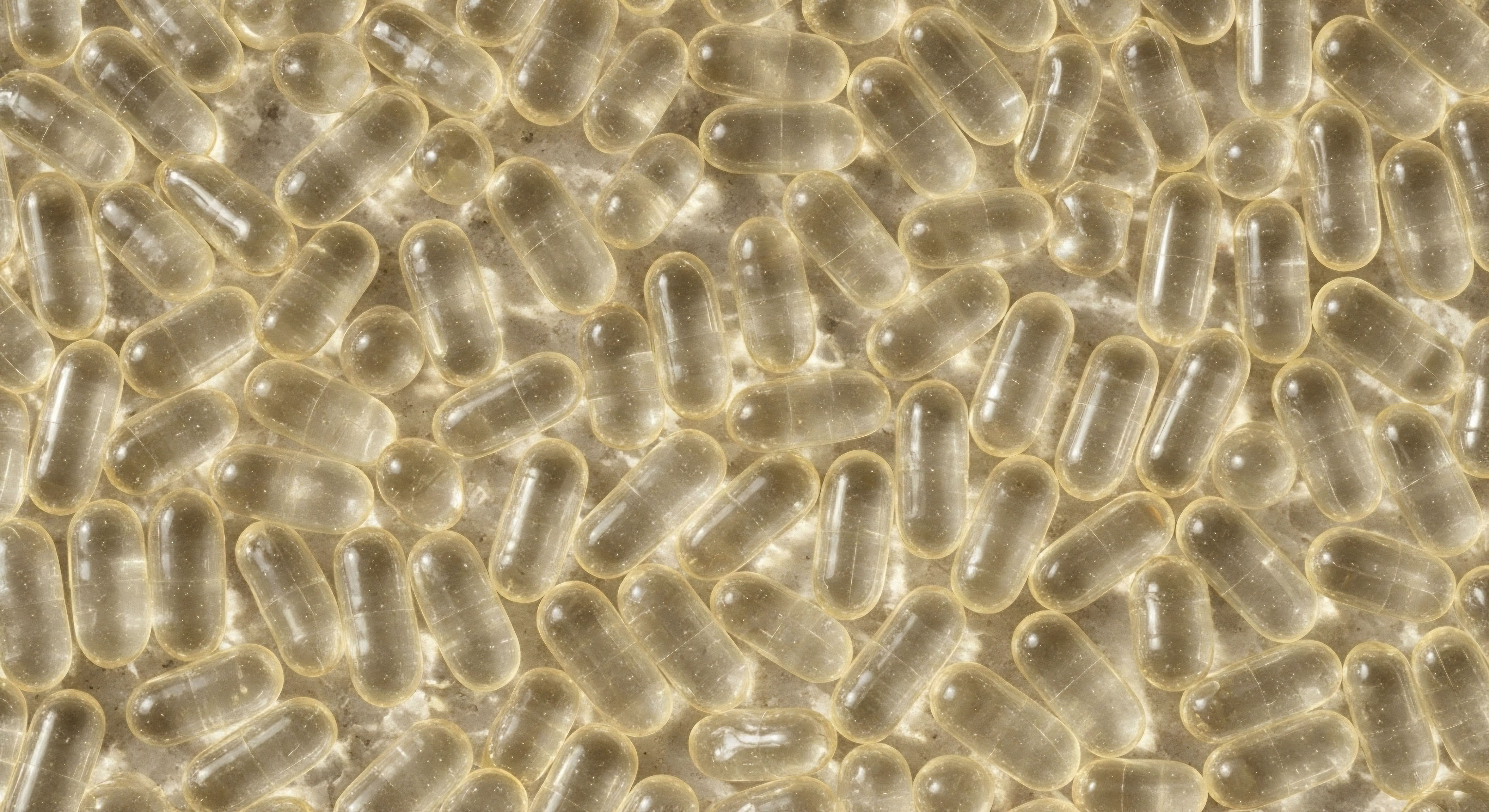

Fundamentals
Have you ever felt a subtle shift in your daily experience, a quiet erosion of the vitality you once knew? Perhaps your energy levels are not what they used to be, or your sleep patterns have become less restorative.
Many individuals describe a persistent mental fog, a diminished drive, or a change in physical composition that seems resistant to conventional efforts. These feelings are not merely signs of aging; they often signal a deeper, systemic recalibration within your biological systems. Your body communicates through a complex network of chemical messengers, and when these signals become discordant, the effects ripple through every aspect of your well-being.
Understanding these internal communications is the first step toward reclaiming your optimal function. Hormones serve as the body’s primary messaging service, directing countless physiological processes. They orchestrate everything from your metabolic rate and mood stability to your sleep cycles and physical strength.
A decline or imbalance in these vital compounds can manifest as a range of symptoms, from persistent fatigue and unexplained weight gain to shifts in emotional equilibrium and a reduction in physical performance. Recognizing these signs within your own lived experience provides a powerful starting point for deeper investigation.
The concept of hormonal optimization protocols extends beyond simply addressing immediate symptoms. It involves a thoughtful, long-range view of your health. This approach acknowledges that your biological systems are dynamic, constantly adapting to internal and external influences.
Sustained well-being requires more than a temporary fix; it calls for a strategic partnership with your body’s innate intelligence, guiding it back toward a state of equilibrium. This perspective shifts the focus from merely managing discomfort to proactively supporting your healthspan, allowing you to maintain vigor and cognitive sharpness for years to come.
Hormonal optimization protocols offer a strategic path to long-term well-being, moving beyond symptom management to support the body’s inherent capacity for balance.

The Body’s Internal Messaging System
Your endocrine system, a collection of glands that produce and secrete hormones, functions as a sophisticated internal communication network. These chemical signals travel through your bloodstream, reaching target cells and tissues to initiate specific responses. Consider testosterone, for instance. In men, it contributes to muscle mass, bone density, and mental acuity.
For women, even in smaller amounts, it plays a significant role in libido, energy, and overall vitality. When levels of such critical messengers fluctuate outside optimal ranges, the body’s orchestration can falter.
The precise regulation of these messengers is paramount. The body employs intricate feedback loops to maintain hormonal balance. When a hormone level rises, the system often responds by reducing its production, and conversely, when levels fall, production may increase. This self-regulating mechanism works diligently to keep your internal environment stable. Over time, however, factors such as aging, environmental stressors, and lifestyle choices can disrupt these delicate feedback systems, leading to a gradual decline in hormonal output or receptor sensitivity.

Why a Long-Range View Matters
Considering hormonal support, a long-range perspective becomes essential. Short-term symptom relief, while valuable, represents only one aspect of a comprehensive strategy. The true benefit of these protocols lies in their capacity to influence systemic health markers over decades. This includes supporting cardiovascular health, preserving bone mineral density, and maintaining metabolic efficiency. A proactive stance against age-related decline can significantly alter your trajectory of health.
Addressing hormonal shifts proactively can mitigate risks associated with their imbalance. For example, declining estrogen levels in women after menopause can contribute to bone loss and cardiovascular changes. Similarly, reduced testosterone in men can affect muscle preservation and metabolic regulation. Thoughtful intervention, guided by precise data, aims to mitigate these long-term health challenges, allowing for a more robust and resilient biological system.


Intermediate
Transitioning from a general understanding of hormonal influence, we now examine the specific clinical protocols employed to restore systemic balance. These interventions are not uniform; they are carefully tailored to individual physiological needs, considering factors such as age, biological sex, symptom presentation, and laboratory findings. The objective extends beyond simply raising a hormone level; it involves guiding the body toward a more harmonious state, respecting its complex feedback mechanisms.
The selection of therapeutic agents and their administration routes holds considerable importance. Different compounds interact with the body in distinct ways, influencing absorption, metabolism, and potential systemic effects. A precise understanding of these pharmacological properties is vital for achieving desired outcomes while minimizing unintended consequences. This section will detail common approaches, explaining the rationale behind their application.

Testosterone Restoration Protocols for Men
For men experiencing symptoms associated with reduced testosterone, often termed andropause or late-onset hypogonadism, testosterone restoration therapy (TRT) offers a pathway to improved vitality. Symptoms can include diminished energy, reduced muscle mass, increased body fat, and a decline in libido. The standard approach frequently involves weekly intramuscular injections of Testosterone Cypionate, typically at a concentration of 200mg/ml. This method provides a steady release of the hormone into the bloodstream, avoiding sharp peaks and troughs.
A comprehensive TRT protocol often includes additional agents to maintain the body’s intrinsic hormonal production and manage potential side effects. Gonadorelin, administered via subcutaneous injections twice weekly, helps preserve natural testosterone production by stimulating the pituitary gland to release luteinizing hormone (LH) and follicle-stimulating hormone (FSH).
This action supports testicular function and can be particularly relevant for maintaining fertility. Another common addition is Anastrozole, an oral tablet taken twice weekly. This medication acts as an aromatase inhibitor, reducing the conversion of testosterone into estrogen, which can mitigate estrogen-related side effects such as fluid retention or gynecomastia. In some cases, Enclomiphene may be included to further support LH and FSH levels, promoting endogenous testosterone synthesis.
Testosterone restoration for men involves precise dosing of Testosterone Cypionate, often supplemented with Gonadorelin to preserve natural production and Anastrozole to manage estrogen conversion.

Hormonal Balance Protocols for Women
Women navigating hormonal shifts, particularly during peri-menopause and post-menopause, can also benefit from targeted hormonal support. Symptoms such as irregular cycles, mood fluctuations, hot flashes, and reduced libido often signal changes in estrogen, progesterone, and testosterone levels. Protocols are carefully designed to address these specific imbalances, with a strong emphasis on individualized dosing.
Subcutaneous injections of Testosterone Cypionate are typically used for women, but at much lower doses, often 10 ∞ 20 units (0.1 ∞ 0.2ml) weekly. This small amount can significantly improve energy, mood, and sexual function without masculinizing effects. Progesterone is a vital component, prescribed based on menopausal status.
For women with an intact uterus, progesterone is essential to protect the uterine lining when estrogen is also being used. It also contributes to mood stability and sleep quality. Pellet therapy, involving long-acting testosterone pellets inserted subcutaneously, offers an alternative delivery method, providing consistent hormone levels over several months. Anastrozole may be considered with pellet therapy when appropriate, similar to its use in men, to manage estrogen levels.

Post-Therapy and Fertility Support for Men
For men who have discontinued TRT or are actively seeking to conceive, a specialized protocol helps restore natural hormonal function and support fertility. Exogenous testosterone can suppress the body’s own production, so a structured approach is necessary to reactivate the hypothalamic-pituitary-gonadal (HPG) axis. This protocol commonly includes a combination of agents.
Gonadorelin is a key component, stimulating the release of LH and FSH from the pituitary gland, thereby signaling the testes to resume testosterone and sperm production. Tamoxifen and Clomid (clomiphene citrate) are selective estrogen receptor modulators (SERMs) that block estrogen’s negative feedback on the pituitary, leading to increased LH and FSH secretion.
This encourages the testes to produce more testosterone. Anastrozole may be optionally included to manage estrogen levels during this recalibration phase, preventing excessive estrogen conversion as endogenous testosterone production resumes.

Growth Hormone Peptide Therapies
Beyond traditional hormone replacement, peptide therapies offer targeted support for various physiological goals, particularly for active adults and athletes. These small chains of amino acids can stimulate the body’s own production of growth hormone (GH) or mimic its effects, contributing to anti-aging benefits, muscle gain, fat loss, and improved sleep quality.
Key peptides in this category include:
- Sermorelin ∞ A growth hormone-releasing hormone (GHRH) analog that stimulates the pituitary gland to secrete GH.
- Ipamorelin / CJC-1295 ∞ A combination that provides a sustained, pulsatile release of GH, promoting lean body mass and fat reduction.
- Tesamorelin ∞ A GHRH analog specifically approved for reducing visceral fat.
- Hexarelin ∞ A potent GH secretagogue that also has cardioprotective properties.
- MK-677 (Ibutamoren) ∞ An oral GH secretagogue that increases GH and IGF-1 levels.

Other Targeted Peptides
The utility of peptides extends to other specific health concerns. PT-141 (Bremelanotide) is a peptide used for sexual health, acting on the melanocortin receptors in the brain to improve libido and sexual function in both men and women. Pentadeca Arginate (PDA) is gaining recognition for its role in tissue repair, accelerating healing processes, and reducing inflammation. These specialized peptides represent a frontier in personalized wellness, offering precise biological signaling for targeted outcomes.
Peptide therapies, such as Sermorelin and Ipamorelin, stimulate the body’s own growth hormone production, supporting muscle, fat loss, and sleep.

Comparing Hormone Optimization Protocols
The choice of protocol depends heavily on the individual’s specific needs and health objectives. A detailed assessment, including comprehensive laboratory testing, guides the selection process. The table below provides a comparative overview of the primary hormone optimization approaches discussed.
| Protocol Type | Primary Target Audience | Key Hormones/Peptides | Main Objectives |
|---|---|---|---|
| Testosterone Restoration (Men) | Middle-aged to older men with low testosterone symptoms | Testosterone Cypionate, Gonadorelin, Anastrozole, Enclomiphene | Restore vitality, muscle mass, libido, cognitive function |
| Hormonal Balance (Women) | Peri/post-menopausal women with hormonal symptoms | Testosterone Cypionate (low dose), Progesterone, Estrogen (if needed) | Improve mood, energy, libido, reduce hot flashes, support bone health |
| Post-TRT/Fertility (Men) | Men discontinuing TRT or seeking conception | Gonadorelin, Tamoxifen, Clomid, Anastrozole (optional) | Reactivate natural testosterone production, support fertility |
| Growth Hormone Peptides | Active adults, athletes seeking anti-aging, performance | Sermorelin, Ipamorelin/CJC-1295, Tesamorelin, Hexarelin, MK-677 | Improve body composition, sleep, recovery, anti-aging effects |
| Targeted Peptides | Individuals with specific sexual health or healing needs | PT-141, Pentadeca Arginate (PDA) | Enhance sexual function, accelerate tissue repair, reduce inflammation |


Academic
A deeper examination of hormone optimization protocols necessitates a thorough understanding of the underlying endocrinology and systems biology. These interventions do not simply add substances to the body; they interact with complex regulatory networks, influencing cellular signaling, gene expression, and metabolic pathways. The long-term implications of these interactions are central to a comprehensive clinical perspective.
The endocrine system operates through intricate feedback loops, particularly the hypothalamic-pituitary-gonadal (HPG) axis. This axis represents a sophisticated communication pathway between the hypothalamus in the brain, the pituitary gland, and the gonads (testes in men, ovaries in women).
The hypothalamus releases gonadotropin-releasing hormone (GnRH), which stimulates the pituitary to secrete luteinizing hormone (LH) and follicle-stimulating hormone (FSH). These gonadotropins then act on the gonads to produce sex hormones, such as testosterone and estrogen. Exogenous hormone administration can suppress this natural axis, a critical consideration for long-term management.

The HPG Axis and Exogenous Hormones
When testosterone is administered externally, the body’s sensors detect elevated levels, signaling the hypothalamus and pituitary to reduce their output of GnRH, LH, and FSH. This suppression is a natural physiological response to maintain homeostasis. Over extended periods, this can lead to testicular atrophy in men or ovarian quiescence in women, as the gonads receive less stimulation.
Protocols that incorporate agents like Gonadorelin or SERMs (Tamoxifen, Clomid) aim to mitigate this suppression, preserving the integrity of the HPG axis, especially when fertility is a concern or when discontinuing therapy.
The long-term effects of HPG axis modulation extend beyond reproductive function. The continuous feedback between the brain and gonads influences mood, cognitive function, and overall metabolic health. Maintaining a degree of endogenous production, even while supplementing, can contribute to a more stable physiological environment. This systemic recalibration supports the body’s intrinsic regulatory capacities.

Hormonal Influence on Metabolic Pathways
Hormones exert profound effects on metabolic function, influencing glucose regulation, lipid metabolism, and body composition. Testosterone, for example, plays a role in insulin sensitivity and glucose uptake in muscle tissue. Optimal testosterone levels are associated with improved insulin sensitivity and a more favorable metabolic profile. Conversely, low testosterone can contribute to insulin resistance, increased visceral adiposity, and a higher risk of metabolic syndrome.
Estrogen also significantly impacts metabolic health. It influences glucose homeostasis, lipid profiles, and energy expenditure. In women, declining estrogen levels during menopause can lead to changes in fat distribution, often increasing abdominal adiposity, and may contribute to a decline in insulin sensitivity. Progesterone, while often associated with reproductive health, also has metabolic effects, influencing glucose metabolism and inflammatory responses. The careful balancing of these hormones can support metabolic efficiency and reduce the risk of chronic metabolic conditions.
Hormones significantly influence metabolic pathways, with optimal levels of testosterone and estrogen supporting insulin sensitivity and favorable body composition.

Receptor Sensitivity and Cellular Signaling
The effectiveness of hormone optimization protocols depends not only on circulating hormone levels but also on the sensitivity of cellular receptors. Hormones exert their effects by binding to specific receptors on or within target cells, initiating a cascade of intracellular signaling events. Factors such as chronic inflammation, nutrient deficiencies, and genetic predispositions can alter receptor sensitivity, meaning that even adequate hormone levels may not elicit the desired biological response.
Consider the androgen receptor, which binds testosterone. Its expression and sensitivity can be influenced by various factors, including age and metabolic status. Similarly, estrogen receptors, present in diverse tissues from bone to brain, mediate a wide array of physiological actions.
Long-term success in hormonal support involves strategies that not only provide the necessary hormones but also optimize the cellular environment for effective receptor binding and downstream signaling. This includes addressing systemic inflammation and supporting cellular health through nutritional and lifestyle interventions.

Interplay with Inflammation and Oxidative Stress
The endocrine system is inextricably linked with the body’s inflammatory and oxidative stress pathways. Chronic low-grade inflammation can disrupt hormonal signaling, contributing to conditions like insulin resistance and hypogonadism. Hormones, in turn, can modulate inflammatory responses. For instance, testosterone has anti-inflammatory properties, and its decline can exacerbate systemic inflammation. Estrogen also plays a role in immune modulation and can have anti-inflammatory effects, particularly in younger women.
Oxidative stress, characterized by an imbalance between free radicals and antioxidants, can damage cells and impair endocrine function. Hormonal imbalances can contribute to increased oxidative stress, creating a self-perpetuating cycle of dysfunction. Long-term hormone optimization protocols aim to break this cycle by restoring hormonal balance, which can indirectly reduce systemic inflammation and oxidative burden, thereby supporting cellular integrity and overall physiological resilience.

Clinical Monitoring and Long-Term Vigilance
Sustained success with hormone optimization protocols requires rigorous and ongoing clinical monitoring. This involves regular laboratory assessments of hormone levels, metabolic markers, and other relevant biomarkers. For men on testosterone restoration, monitoring includes total and free testosterone, estradiol, hematocrit, and prostate-specific antigen (PSA). For women, estradiol, progesterone, testosterone, and lipid panels are commonly assessed.
The frequency of monitoring typically begins more often during the initial titration phase, then transitions to periodic checks, often every six to twelve months, once stable levels are achieved. This continuous oversight allows for precise adjustments to dosing and protocol components, ensuring that the body remains within optimal physiological ranges and that any potential long-term considerations are addressed proactively. This systematic approach supports sustained well-being.
| Biomarker Category | Key Markers | Clinical Significance in Optimization |
|---|---|---|
| Sex Hormones | Total Testosterone, Free Testosterone, Estradiol, Progesterone, DHEA-S | Direct assessment of hormonal status; guides dosing and balance. |
| Metabolic Health | Fasting Glucose, HbA1c, Insulin, Lipid Panel (HDL, LDL, Triglycerides) | Evaluates insulin sensitivity, cardiovascular risk, and metabolic efficiency. |
| Blood Count | Hematocrit, Hemoglobin | Monitors red blood cell production, especially with testosterone use. |
| Prostate Health (Men) | PSA (Prostate-Specific Antigen) | Screens for prostate changes, a consideration with testosterone restoration. |
| Bone Health | Bone Mineral Density (DEXA scan), Vitamin D | Assesses skeletal integrity, particularly relevant for estrogen/testosterone. |
| Inflammation | High-Sensitivity C-Reactive Protein (hs-CRP) | Indicates systemic inflammation, which can impact hormonal function. |

References
- Vigen, R. et al. “Association of Testosterone Therapy With Mortality, Myocardial Infarction, and Stroke in Men With Low Testosterone Levels.” JAMA, vol. 310, no. 17, 2013, pp. 1829-1836.
- Stachenfeld, N. S. “Hormonal regulation of fluid and electrolyte balance.” Exercise and Sport Sciences Reviews, vol. 35, no. 3, 2007, pp. 118-124.
- Handelsman, D. J. “Androgen Physiology, Pharmacology, and Abuse.” Endocrine Reviews, vol. 23, no. 5, 2002, pp. 610-631.
- Santoro, N. et al. “Menopausal Hormone Therapy and the Cardiovascular System.” Journal of Clinical Endocrinology & Metabolism, vol. 104, no. 10, 2019, pp. 4391-4402.
- Davis, S. R. et al. “Global Consensus Position Statement on the Use of Testosterone Therapy for Women.” Journal of Clinical Endocrinology & Metabolism, vol. 104, no. 10, 2019, pp. 4660-4666.
- Gherman, R. B. et al. “Gonadotropin-releasing hormone agonists and antagonists ∞ an update.” Obstetrics & Gynecology Clinics of North America, vol. 30, no. 2, 2003, pp. 277-294.
- Ho, K. K. Y. et al. “Growth Hormone and Aging ∞ A Review.” Endocrine Reviews, vol. 36, no. 1, 2015, pp. 25-52.
- Walker, R. F. et al. “The role of peptides in the regulation of growth hormone secretion.” Growth Hormone & IGF Research, vol. 10, no. 2, 2000, pp. 103-110.
- Shufelt, C. L. et al. “Hormone therapy and cardiovascular disease ∞ the Endocrine Society 2017 Scientific Statement.” Endocrine Reviews, vol. 38, no. 1, 2017, pp. 1-29.
- Veldhuis, J. D. et al. “Growth hormone (GH) pulsatility in humans ∞ a paradigm for neuroendocrine regulation.” Journal of Clinical Endocrinology & Metabolism, vol. 84, no. 1, 1999, pp. 1-9.

Reflection
The exploration of hormonal optimization protocols reveals a profound truth ∞ your body possesses an extraordinary capacity for self-regulation and restoration. The information presented here serves as a guide, offering a framework for understanding the intricate biological systems that govern your vitality. This knowledge is not merely academic; it is a call to introspection, inviting you to consider your own unique biological landscape.
Your personal health trajectory is a dynamic process, influenced by countless variables. The insights gained from examining these protocols can serve as a catalyst for a more informed dialogue with your healthcare provider. It encourages a partnership approach, where your lived experience and clinical data converge to shape a path toward sustained well-being. The journey toward optimal health is deeply personal, requiring continuous attention and thoughtful adjustments.

What Are the Regulatory Frameworks for Hormone Optimization Protocols?
Considering the evolving landscape of medical interventions, how do regulatory bodies ensure the safety and efficacy of these specialized protocols? The oversight of therapeutic agents and their clinical application is a complex area, varying across different jurisdictions. Understanding these frameworks provides a layer of assurance regarding the standards of care.

How Do Long-Term Monitoring Strategies Adapt for Individual Variability?
Given the unique biological responses of each person, how are long-term monitoring strategies customized to account for individual variability in hormonal and metabolic responses? A static approach rarely yields optimal results; instead, dynamic adjustments based on ongoing assessments are paramount.

What Are the Economic Considerations for Sustained Hormone Optimization?
Beyond the clinical aspects, what financial implications might individuals encounter when pursuing sustained hormone optimization protocols? Access to and affordability of these specialized therapies can influence long-term adherence and overall health outcomes.



